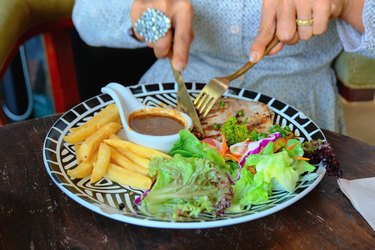
So often when it comes to losing weight, we put a huge focus on eating less. We watch our portions, make healthier choices or perhaps track calories, all in an effort to reduce the amount of food, and overall calories, we put into our mouths.
But what if there are other methods you can try that don't require so much focus on what and how much you're eating, but instead, involve small behavioral or environmental changes you can make, in some cases almost subconsciously, that will help you eat less?
Video of the Day
Video of the Day
Enter these four simple, science-backed hacks you can use to train yourself to eat less when you sit down to any meal.
1. Stay Off Your Phone
Ever try to get a head start on your day by checking your email over breakfast? Or perhaps you like to scroll your social media feeds at lunch? You're not alone. A January 2018 survey conducted by Nutrisystem found that one-third of Americans can't get through a meal without getting on their phone.
This distraction may seem benign, but when it comes to actually enjoying your meal and being aware of how much you're eating, the effects can be significant.
Researchers in a February 2011 study in the American Journal of Clinical Nutrition tested the effect by breaking 44 subjects into two groups and allowing one of the groups to play a game on their phone over lunch. All of the subjects ate nine savory items for lunch and were asked to rate their hunger along with recalling what they ate immediately following the meal. Thirty minutes later, they took part in a biscuit taste test.
It turns out, the distracted group felt less full after lunch and they ate significantly more biscuits in the taste test afterwards. They were also less accurate in reporting the order of the foods they ate at lunch.
Training yourself to eat less, then, may be as simple as putting down your phone and paying closer attention to what's on your plate.
Related Reading
2. Eat With a Utensil (or Be More Mindful When You Don’t)

Taco Tuesdays with chips, guac and tacos can be delicious, yes, but they may also lead to overeating — but not for reasons you might think.
When we eat with our hands (e.g. tacos, chicken wings, etc.), our sensory experience is increased by the direct touch, which adds to the overall pleasure of the food. This has shown to also lead to increasing our consumption, according to a December 2019 paper in the Journal of Retailing.
So does this mean no more pizza or fries? Not at all. Just be mindful when eating with your hands. Food is meant to be enjoyed, but just be aware that part of that pleasure may be stemming from feeling the food — it's not your actual appetite leading the consumption.
Related Reading
3. Put Down Your Fork Between Bites
The next time you sit down to a meal, challenge yourself to pause between bites and actually put your fork down.
Why? A July 2014 meta-analysis in the American Journal of Clinical Nutrition found that eating at a slower rate may lead to a significant reduction in how much you eat. The study compiled the findings of 22 research studies looking at the rate of how quickly we eat our food and the results consistently supported the cause to slow down.
There are a few reasons why taking a beat may be in your favor: The researchers suggest eating at a slower rate may influence satiety hormones, making you feel fuller faster. It may also have to do with the duration and intensity of oral exposure to food — if you eat quickly, you have a lower duration of sensory exposure, so you eat more. On the other hand, slowing down may help you train yourself to eat less.
4. Drink Before You Dig In

We know getting enough H2O is good for our overall health, but when you drink may also help you manage your weight.
An August 2015 Obesity study found that drinking water before a meal may help you eat less and lose weight. Subjects in the study consumed about two cups of water 30 minutes before each main meal. This led to a moderate weight loss over the course of 12 weeks for the water-drinking group — they lost about 2.5 pounds more than the control group.
If you find it difficult to drink plain water, adding fresh fruit, sliced cucumbers and/or herbs is a delicious way to boost flavor without adding sugar or calories.
A Few Unproven Methods
There are many other tips and tricks you've probably read about — like eating from a smaller plate — that are supposed to help you train yourself to eat less.
Unfortunately, significant flaws and misreporting have been found in many of the studies looking at the behavioral changes we can make to our environment and the effect this has on our consumption. It's not to say these methods definitely don't work, but it's important to note that there's no valid research to back them, either.
Some of these methods or ideas include:
- You'll eat more if you sit closer to the buffet table at an all-you-can-eat restaurant.
- You eat more when served in a larger bowl.
- Eat with a small spoon or chopsticks to slow down your rate of eating.
- Reduce contrast between your food and your plates (e.g. serve cauliflower, mashed potatoes or oatmeal with white dishware) because a higher contrast means you'll eat more.
- Drink from a tall, slender glass instead of a short, wide glass because you'll pour yourself less.
- Don't eat directly from a package. Instead, pre-portion how much you're going to eat.
- Nutrisystem: "1 in 3 Americans Can’t Eat A Meal without Being on Their Phone"
- American Journal of Clinical Nutrition: "Playing a Computer Game During Lunch Affects Fullness, Memory for Lunch, and Later Snack Intake"
- American Journal of Clinical Nutrition: "A Systematic Review and Meta-Analysis Examining the Effect of Eating Rate on Energy Intake and Hunger"
- Journal of Retailing: "Self-Control and Touch: When Does Direct Versus Indirect Touch Increase Hedonic Evaluations and Consumption of Food"
- Obesity: "Efficacy of Water Preloading Before main Meals as a Strategy for Weight Loss in Primary Care Patients with Obesity: RCT"